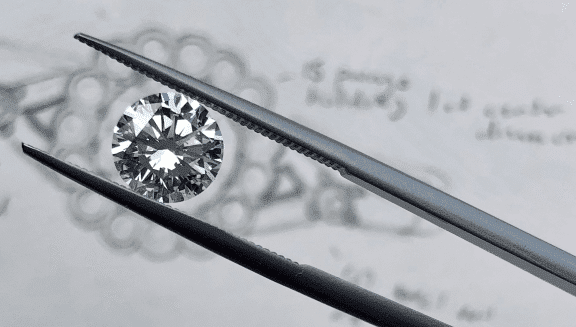Diamonds, Lab-Grown Diamonds and Lab-Grown Moissanite: What’s the Difference?
If you’re in the market for a new piece of jewelry or looking for an engagement ring, it is important to research which stone best fits your lifestyle and your values. Natural, mined diamonds, lab-grown diamonds, and lab-grown moissanite are among the most popular precious stones currently used in engagement rings, but the similarities and differences between them often get confused. We’ve put together an overview of what you need to know about each stone to help you make informed decisions on jewelry that you’ll want to pass onto future generations.
Diamonds
Diamonds are one of the most popular and widely used stones in the jewelry industry. From the first recorded diamond engagement ring in 1477 to modern day, diamonds are highly sought after. Admired for their sparkle and fire, consumers spend billions of dollars on diamonds and jewelry each year in the United States. The amount of money spent on diamonds is often more than all other stones combined.
How Do Diamonds Form?
Diamonds naturally form miles below the Earth’s crust. Diamonds begin as carbon that is exposed to extremely high temperature (about 2,200 degrees Fahrenheit) and squeezed under immense pressure (725,000 pounds per square inch) from one to billions of years. Through deep volcanic eruptions, these hot rocks are blasted up to the surface where they cool so rapidly they retain their shape. After surfacing, a diamond’s natural form is rough with milky skin that hides the spark within. It takes an experienced cutter to make precise cuts that give the diamond it’s brightest shine. These facets intentionally work like mirrors causing light to bounce in and out of the clearest part of the stone. A well-cut diamond can be breathtaking!
Durability
One of the best known slogans in the world is “A Diamond is Forever.” Not only does it symbolize an everlasting love, but it really is true- a diamond has no limit to existence if it’s taken care of! Part of a diamond’s eternal appeal lies in its extremely durable nature. Meaning “invincible or indestructible” in Greek, diamonds are a 10 on the Mohs Scale of Hardness making them one of the hardest known naturally occurring materials on Earth. In this way, they are resistant to scratching, unless by another diamond, and highly resistant to breaking and chipping. Diamonds are also extremely stable, having the capacity to withstand extreme chemical and temperature changes. Because of these characteristics, diamonds are a great investment and are often passed down generations.
(1.31 carat diamond asymmetrical oval cluster engagement ring, The Emily).
Diamond Characteristics
Each diamond that comes out of the Earth is unique and each is given an identity and value based primarily on four factors: color, cut, clarity, and carat weight. Diamonds come in a range of colors from yellow to brown, but colorless diamonds are what most people recognize and covet. In general, diamonds have a high brilliance, a refractive index of about 2.4, and lots of fire. Though it may seem that diamonds are absolutely perfect, few natural things are. Most diamonds have imperfections called inclusions. These naturally-made irregularities, in conjunction with many other factors such as the color, cut, and carat weight as well, affect the cost of a diamond. Though clearer diamonds go for a steeper price, many people like the uniqueness an inclusion can give to a diamond. The carat weight of a diamond is the more obvious factor for judging value. Precisely weighed, the higher the carat weight, the higher the price tag.
Why Choose Diamonds?
Diamonds are one of the most popular and well known stones for engagement rings. If you or your significant other want a white, sparkly, durable treasure that’s found naturally in the earth, you have ample budget, and are not particularly interested in the origin of your stone, then a diamond is for you. With a high refractive index and extreme durability, a diamond can last forever like the Emily engagement ring shown above.
Lab-Grown Diamonds
It’s a common misconception that lab-grown diamonds are not real diamonds. Though lab-grown diamonds are not extracted from the Earth and instead cultured in a laboratory, their chemical composition and physical characteristics are the same as mined diamonds. These stones are just as dazzling and beautiful as mined diamonds though! Just look at the Kelly, lab-grown diamond engagement ring shown below. Lab-grown diamonds are often referred to as synthetic diamonds given their man-made origin, however, we at ASJ feel like “synthetic” isn’t a term that properly reflects their true diamond nature- after all, the difference between a lab-grown diamond and a mined diamond is origin. While the term synthetic is associated by consumers with imitation products, artificial diamonds are made of the same material (pure carbon, crystallized in isotropic 3D form. Accordingly, we refer to them as lab-grown diamonds in our community.
How are Lab-Grown Diamonds Made?
The majority of lab-grown diamonds are grown under techniques called Chemical Vapor Deposition (CVD) or high-pressure high-temperature (HPHT) crystal formation. Carbon atoms are extracted from carbon rich vapor in a chamber. Layer by layer, the stone’s crystal structure forms and is built up until a diamond forms. This process takes about 3 months for many lab-grown diamonds, however, it can take longer, whereas a natural diamond takes many years to form.
(1.06 carat ethical princess cut diamond engagement ring, The Ginny)
Difference Between Lab-Grown Diamonds and Diamonds
From a jewelry perspective, the main difference between lab-grown diamonds and natural, mined diamonds is their origin- where they are formed and how long it takes to make them. One is created in a lab and the other is created in the Earth, however, their chemical compositions are made of exactly the same properties, namely carbon atoms. In fact, diamonds grown in a lab that are at a quality level to be used in jewelry can be chemically, physically and optically identical (and sometimes even superior) to naturally occurring ones. So if these stones are the same, why choose a lab-grown diamond over a mined one? Many people opt for lab-grown diamonds because they are more ethical. These stones are cultured in a controlled environment, so consumers know exactly where the diamond was created and what went into the process. Lab-grown diamonds also typically sell for about 15–20% less than natural, mined equivalents, making them a favorite for more budget conscious shoppers.
Why Choose Lab-Grown Diamonds?
If you love the look, sparkle, and history of a diamond but you are concerned about the ethical or sustainable origin of your bling then a lab-grown diamond is likely the way to go for your engagement ring. Not only will you be getting a genuine diamond, but you’ll know the origin of your diamond because it was made in a lab. And let’s not forget that lab-grown diamonds are slightly less expensive than mined, natural diamonds for those on a tight budget, giving you more bang for your buck.
Lab-Grown Moissanite
Natural diamonds are from the earth. Lab-grown diamonds are from labs. Where is moissanite from? The stars! Although moissanite has a similar look to diamonds with its white color, brilliant sparkle, and mesmerizing facets, moissanite is not a diamond and in fact, it’s not trying to be. Lab-grown moissanite is not a diamond substitute, but rather it is an alternative to diamonds. Discovered and named after Nobel Prize-winning chemist Dr. Henri Moissan in 1893, moissanite fell to earth in a meteorite. Due to the fact that natural moissanite is very rare and found only in a few places on Earth (upper mantle rock and tops of volcanoes for example), most moissanite on the market at this time is lab-grown moissanite. Lab-grown moissanite is growing in popularity for engagement rings alternatives due to the gemstone having a high refractive index and dazzling fire (sparkle).
(1.10 carat moissanite constellation engagement ring, The Sarah)
How is Lab-Grown Moissanite Made?
After Moissan discovered moissanite, he spent the rest of his life trying to recreate it. Finally, in the 1990’s, through a combination of science and art, scientists were able to thermally grown silicon carbide crystals to create this stunning gemstone. In 1988, Charles and Colvard, the original creator of commercial moissanite, introduced lab-grown moissanite to the jewelry market. The process of growing moissanite is very complicated and expensive, so a single gem of lab-grown moissanite takes about two to three months to create.
Lab-Grown Moissanite Characteristics
Ranging from 2.65 to 2.69 on the refractive scale, lab-grown moissanite has a higher refractive index than diamonds. This means that lab-grown moissanite has a higher level of sparkle and brilliance due to its ability to disperse light better than diamonds. Its fire exceeds that of any popular gemstone, with a dispersion of 0.104. Lab-grown moissanite is also very durable. The second hardest stone next to diamonds, with a hardness of 9.25 on the Mohs Scale of Hardness, lab-grown moissanite does not break easily and is very resistant to heat. Not only is moissanite beautiful and tough, but also many people choose moissanite over diamonds because of its ethical and eco friendly origin. Since these gemstones are created in a lab, there are no ethical concerns pertaining to gem mining processes. In addition, the cost of lab-grown moissanite jewelry can be significantly less than that of diamonds. In fact, some custom engagement rings with lab-grown moissanite center stones, like the Sarah shown above, can cost about 50% less than the same custom engagement ring with a natural center diamond. The cost and dazzle alone of lab-grown moissanite have it growing in popularity.
Why Choose Lab-Grown Moissanite?
If you’re considering lab-grown moissanite for your unique engagement ring, chances are that you might be more unconventional in your engagement ring preferences in that you might not want a diamond but still want a white stone with a high level of sparkle. Not only does lab-grown moissanite have a brilliance that exceeds that of diamonds, but also you can be more value forward in your approach to your engagement ring and better stretch your budget since lab-grown moissanite is more affordable than the diamond equivalent. Lastly, lab-grown moissanite has the ethical appeal in its origin for those that want both value and sustainability in an engagement ring.
(1.50 carat moissanite and diamond swirl engagement ring, The Paige).
To recap:
- Natural diamonds are mined from the Earth and have a geological origin.
- Lab-grown diamonds are grown in a laboratory and so have a manmade origin
- Natural diamonds and lab-grown diamonds are chemically, physically and optically identical, so the differences are origin and also cost since lab-grown diamonds are more affordable.
- Lab-grown moissanite is not a diamond but in fact its own unique gemstones with a fire and brilliance comparable to that of a diamond.
- Lab-grown moissanite is grown in a laboratory and so have a manmade origin. They are substantially more affordable than either lab-grown diamonds or natural diamonds.
So why does all of this matter when thinking about clear stone options for engagement rings? Because every woman is different and unique regarding what she wants in her forever ring! Lab-grown diamond engagement rings are a great option for the woman who wants a diamond but values ethics over natural origin, while also saving a bit of money. Natural, mined diamond engagement rings are for the woman who wants a diamond and wants her diamond to be natural and come from the Earth. Lab-grown moissanite engagement rings are a great option for the woman who does not want a diamond and who values ethics over natural origin. It is also a great option for those who are on a tight budget but want to maximize sparkle. If you would like to learn more about the custom design process around creating a custom engagement ring with one of these stone options, we are here to help. Engagement ring financing available.










Comments